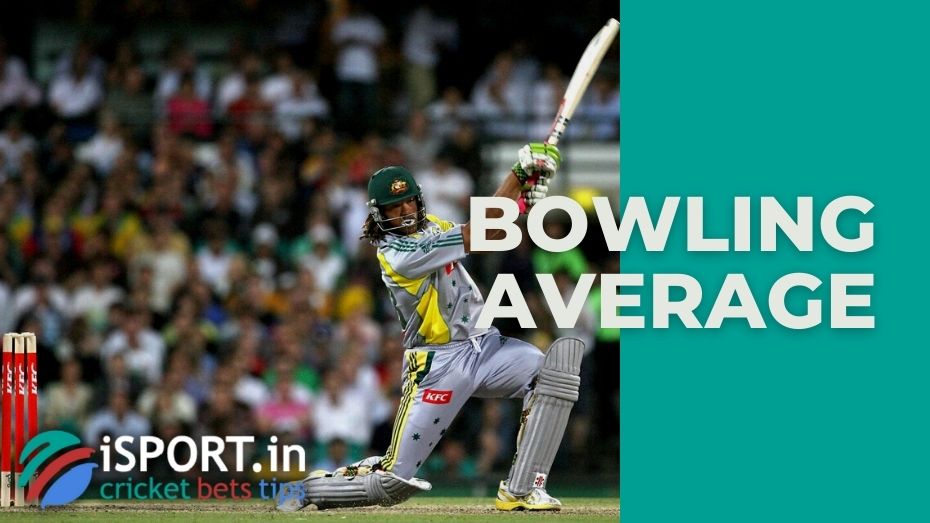Bowling average

Bowling average is a crucial measure for attacking cricketers, and it is one of the most essential indicators. It refers to the number of runs that are scored for each wicket that is achieved. Considering that you are a skilled cricket player, you should try to keep this number as low as possible. It should come as no surprise that the administration of the team chooses fresh players for their team upon the basis of the bowling average.
Bowling Average: The Basic Meaning
An attacking cricketer needs to have as little bowling average as possible. For defenders, on the contrary, the higher the batting average, the better. The bowling average is calculated using the following formula:
Bowling average = Runs conceded/Wickets taken.
When calculating the bowling average, it is standard procedure to also consider the economy rate and the strike rate respectively. Much like the batting average, restrictions are implemented to identify the most talented players. However, if the number of innings for defenders is carefully limited (to 20), there are no such restrictions for attacking players. Despite this, there are still some restrictions that are occasionally altered by different specialized agencies.
How is the total amount of runs that a bowler has allowed to be scored determined? The total amount of runs is the sum of all the runs scored by the opponent while the bowler was attacking. In certain circumstances, such as the ones listed below:
- Any byes.
- Leg byes or penalty runs.
Whether a wicket is bowled, caught, hit, or stumped, the bowler is credited with the wicket. Numerous individuals are skeptical of the rules that are now in place for the distribution of the bowling average. However, there are some people who disagree with the notion that a player who has not yet taken a wicket is unable to have a bowling average. A peculiar circumstance develops as a consequence of this: the bowling average of a player who missed a wicket and one run will not be different from that of another player who missed a wicket and more than 20 runs.
An example of a cricket player’s bowling average would be fifty if he scored one hundred runs and take two wickets in each match. The indication of a player will be significantly improved to 16.7 if he takes six wickets while scoring the same number of runs. In the process of registering records, an additional set of conditions is taken into consideration.
Bowling Average: What Factors Influence?
However, the bowling average is not just determined by the player’s skill, it is also affected by external circumstances. For instance, during the 18th century, cricket players were had to play on unfavorable grounds that may have pits and stones of various sizes. This occurred due to the fact that cricket was not a popular sport and the pitches were not well maintained.
As a result of the apartheid regime that was implemented in South Africa throughout the latter half of the 20th century, the country was barred from participating in international matches for a period of more than twenty years. The Africans made the decision to have a Howa Bowl event in South Africa, although the circumstances would not be suitable for the participants. An example of this would be the fact that the wickets were not fastened very well, which provided the bowlers with it.
During the 20th century, players were not given with adequate safety equipment (helmets, gloves), according to specialists in the field of cricket. The batters hit the balls with a greater degree of caution than they do at the moment as a result of this. In the 21st century, teams frequently compete against individuals from different teams, which also has an impact on the bowling average.
Bowling Average: The Best Cricketers
The only format in which record indications are deemed to be worthy of consideration is the test format. This is because the assessment criteria for the bowling average are constantly shifting during the test. Wisden Cricketers’ Almanack, ESPNcricinfo, and CricketArchiv are the three most prominent cricket agencies in the world, and if we take their opinions into consideration, we find that George Lohmann, who hails from England, is in the lead in this regard.
When compared to other players who had taken at least 15 wickets, he had the lowest bowling average of all those who played throughout the latter half of the 19th century. George Lohmann also held the position of having the second highest rank among bowlers in the International Cricket Council rating during the entirety of the classification’s history.
A rating of the top bowlers in history has been created by the ESPNcricinfo assistance, which indicates a maximum of ten wickets taken by each bowler ranked. The number one spot on the list was held by Charles Marriott, who was from England. Between the years 1919 and 1938, he was widely regarded as one of the best bowlers throughout the entire world. Marriott was 37 years old when he made his debut for the national squad in 1933, and he ended up capturing 11 wickets.
Test matches (top-10)
Cricketer Bowling average
- Charles Marriott (England) 8,72
- Frederick Martin (England) 10,07
- George Lohmann (England) 10,75
- Laurie Nash (Australian) 12,60
- John Ferris (Australia/England) 12,70
- Tom Horan (Australia) 13,00
- Harry Dean (England) 13,90
- Albert Trott (Australia/England) 15,00
- Mike Procter (Southern Africa) 15,02
- Jack Iverson (Australia) 15,23
In the One Day International format, the ESPNcricinfo rating is the most trusted, according to the terms of which you need to have 1000 deliveries. Joel Garner, who played for the West Indies national team, leads the classification. He has a score of 18.84. ESPNcricinfo considers Gill Smith to be the best women bowler (12.53).
In the Twenty20 format, ESPNcricinfo sets the requirement of just 30 balls to have been bowled and considers George O’Brien to be the leader (8.20).
